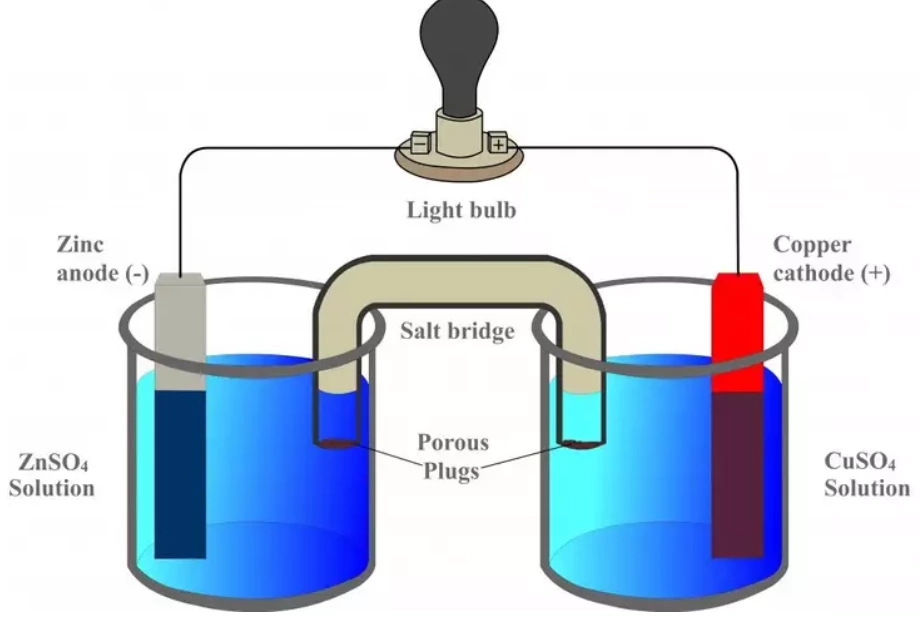Galvanic Cell
A galvanic cell converts chemical energy into electrical energy. It accomplishes this by utilizing the energy created by the redox reactions that take place inside the cell.
What is a Redox Reaction?
"Redox" is a term used to combine "reduction-oxidation". It expresses two chemical reactions that happen at the same time to transfer electrons.
The reactant that donates its electrons is considered to be oxidized, while the reactant that gains these same electrons is said to be reduced. It is noteworthy that one causes the other, and it is this underlying nature of the chemical reaction that terms the "red-ox" reaction.
Historical Aspects of Galvanic Cell
The cell is named "galvanic" after its creator, the physicist Luigi Galvani. In 1780, Galvani proved that when two different metals are connected with one another toward one end, while the other ends are coonected by the legs of a frog, the legs contract, showing the progression of electricity. He called his ludicrous mechanical assembly “animal circuitry”.
To counter the theory of Galvani, Alessandro Volta built up a similar cell without biological component. This was an inconceivable accomplishment and, hence, the terms "galvanic" and "voltaic" are used synonymously.
Despite the fact that their circuits worked, the creators were wrong regarding why they worked. Galvani accepted that the frog was capable, while Volta trusted it was the properties of the unique metals.
Thereafter, Michael Faraday corrected the theory of electricity production that the electric energy was obtained from chemical reactions, that the origin of voltage was absolutely chemical. It was Faraday who authored the terms that presently structure electrical and electronic language: he called them (metal terminals) as electrodes – cathode and anode, the solution where they were immersed, he called it as electrolyte, and the atomic particles included were termed as ions – cations and anions.
Galvanic Cell Apparatus
Following diagram represents the apparatus for a standard galvanic cell.

In the first beaker, there is zinc sulfate (ZnSO4) into which a zinc strip is immersed, while the second beaker has copper sulfate (CuSO4) into which a copper strip is immersed. Both strips are linked or connected to an external circuit, a conductor, which is connected with a bulb.
When the zinc and copper electrodes are immersed into their separate sulfate electrolytes, the redox reaction starts: copper starts to attract zinc's electrons. Similarly, as it happened in the single beaker experiment, the zinc atoms in the first beaker are oxidized and they lose their electrons and become zinc ions, which break up into the zinc sulfate solution. The copper ions in the neighboring beaker are decreased as they gain these electrons and become copper atoms, which adhered on the strip.
The two beakers are separated physically, an outside conductor links the electrodes. The electrons, instead of scattering, are steered to the copper cathode using this conductor. Nonetheless, because roosted on this conductor is a bulb, before arriving at the copper strip, the electrons have no option yet to experience the bulb. The zinc anode, since it supplies the electrons, is the battery's anode or the negative terminal. In contrast, the copper cathode, which pulls in or gets the electrons, is the battery's cathode or the positive terminal. Since one metal will undoubtedly take electrons from the other metal (or non-metal), the electronegativity decides the direction of the circuit's current.
Salt Bridge
The salt bridge is a permeable substance made out of a salt on which electrons cannot traverse, but cations and anions can. By disallowing the progression of electrons, it consequently prohibits itself from invliving in the process. Its sole design is to exchnage ions and complete the electric circuit.
At the point when zinc oxidizes and breaks down into the solution as a zinc cation, the zinc cation crosses the bridge and enters the nearby beaker. There it structures zinc sulfate by replacing the copper cation, which, blended in with the sulfate anion, before being reduced, framed the copper sulfate solution. Correspondingly, when the copper cation decreases to shape a copper atom, the sulfate anion deserted navigates the bridge and enters the main beaker. There it consolidates with the oxidized zinc cations to shape zinc sulfate. The exchange of ions guarantees that the reaction is adjusted, or that the circuit is finished.
As the reduction and oxidation reactions happen in two distinct beakers, each beaker or unit is known as a half cell. The voltage in one direction, that is the flow of electrons, is DC. The intensity of this DC voltage is the arithemetic difference of the voltages in the two half cells. The distinction gives an overall proportion of the simplicity of dissolution of the two electrodes into the electrolyte. The voltage is, along these lines, a function of the properties of both the electrodes and the electrolyte.
Currently, batteries do not have a single galvanic cell, yet a couple, or two of them in arrangement. A 12V battery usually comprises of 6 galvanic cells. The battery "dies" when the whole of its anions has been dissociated into the electrolyte, while the total of its cations has been stored upon the cathode. Remember that not all batteries use zinc, copper and their sulfates as the electrodes and the electrolyte. What is essential is the distinction in the electronegativity of the electrodes.
Most of batteries are really founded on lead and lead oxide as anode and cathode, separately. Indeed, even the salt bridge doesn't really need to be made out of a similar salt; the metals structure. It simply needs to give the vital number of cations and anions to adjust the reaction.

Similar Questions
Describe Galvanic cell or voltaic cell.
03:31View Solutionगैल्वेनीक सेल में -
Text SolutionView SolutionIn galvanic cell
04:21View Solutionintroduction|galvanic cell#!#cell notation
34:18View SolutionWhat is an electrochemical cell or galvanic cell?
02:10View Solutiongalvanic cell is an _____
03:19View SolutionFuel cells are special types of galvanic cells.What are galvanic cells?
02:28View SolutionIn a galvanic cell, the salt bridge:
01:50View Solution
